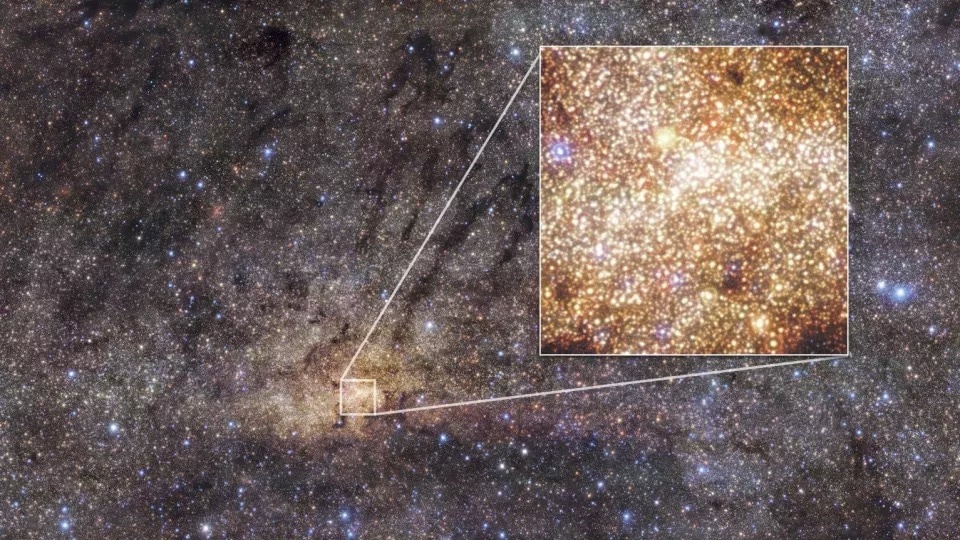By examining high-resolution data obtained from a 10 m telescope in Hawaii, scientists from Lund University in Sweden have attained fresh insights into three stars situated at the core of the Milky Way.
 The image, taken with ESO's Very Large Telescope in Chile, shows a high-resolution view of the innermost parts of the Milky Way. In the new study, the researchers examined the dense nuclear star cluster shown in detail here. Image Credit: ESO.
The image, taken with ESO's Very Large Telescope in Chile, shows a high-resolution view of the innermost parts of the Milky Way. In the new study, the researchers examined the dense nuclear star cluster shown in detail here. Image Credit: ESO.
These stars were unexpectedly young and exhibited a perplexing chemical composition, surprising the researchers with their characteristics.
The study focused on a set of stars within the nuclear star cluster, comprising the core of the Milky Way galaxy. This investigation centered on three distant stars that pose challenges for study due to their vast distance from the solar system.
They are obscured by immense clouds of dust and gas, hindering the passage of light. Furthermore, the region's dense congregation of stars complicates efforts to distinguish individual stars. The study was published in The Astrophysical Journal Letters.
The scientists proposed a hypothesis in their earlier research that these specific stars in the middle of the Milky Way can be unusually young.
We can now confirm this. In our study we have been able to date three of these stars as relatively young, at least as far as astronomers are concerned, with ages of 100 million to about 1 billion years. This can be compared with the sun, which is 4.6 billion years old.
Rebecca Forsberg, Researcher, Astronomy, Lund University
The nuclear star cluster has mostly been recognized as an olden fragment of the galaxy. The innovation of the scientists on such young stars denotes that there is also dynamic star creation happening in this ancient component of the Milky Way. However, dating stars 25,000 light years from Earth cannot be done hurriedly.
The scientists received high-resolution data from the Keck II telescope in Hawaii, which is one of the world’s largest telescopes with a mirror 10 m in diameter. The scientists then measured the quantity of heavy elements, such as iron present in the stars for further confirmation.
This element holds significance in tracing the galaxy's evolution, aligning with astronomers' theories on star formation and galaxy development. According to these theories, younger stars tend to possess a higher abundance of heavy elements. This relationship arises because heavy elements are believed to form increasingly over time within the universe's evolutionary timeline.
The astronomers used infrared light to observe the stars' spectra, as it penetrates the dust-filled regions of the Milky Way more effectively than optical light. This revealed significant variations in iron levels among the stars, surprising the researchers.
The very wide spread of iron levels could indicate that the innermost parts of the galaxy are incredibly inhomogeneous, i.e. unmixed. This is something we had not expected and not only says something about how the center of the galaxy appears but also how the early universe may have looked.
Brian Thorsbro, Researcher, Astronomy, Lund University
The research provides a significant understanding of the early universe and the functioning of the exact center of the Milky Way. These findings could serve as inspiration for ongoing and future explorations within the galaxy's core. They may also contribute to advancing models and simulations regarding the formation of stars and galaxies.
Personally, I think it is very exciting that we can now study the very center of our galaxy with such a high level of detail. These types of measurements have been standard for observations of the galactic disc where we are located, but have been unreachable goal for more faraway and exotic parts of the galaxy. We can learn a lot about how our home galaxy was formed and developed from such studies.
Rebecca Forsberg, Researcher, Astronomy, Lund University
The following organizations and higher education institutions participated in the study in addition to Lund University: Observatoire de la Côte d'Azur, the University of Tokyo, Observatoire de Paris, the University of California Los Angeles, and Miyagi University of Education.
Journal Reference:
Thorsbro, B., et al. (2023). A Wide Metallicity Range for Gyr-old Stars in the Nuclear Star Cluster. The Astrophysical Journal Letters. doi/10.3847/2041-8213/ad08b1.